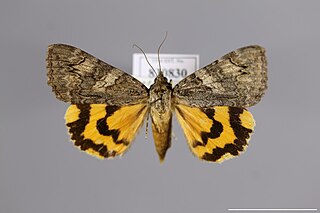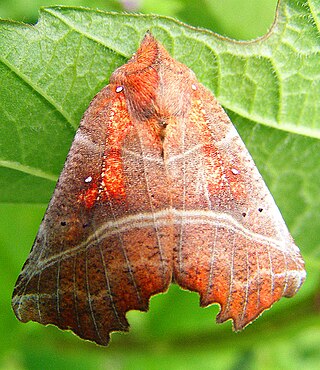
The Arctiinae are a large and diverse subfamily of moths with around 11,000 species found all over the world, including 6,000 neotropical species. This subfamily includes the groups commonly known as tiger moths, which usually have bright colours, footmen, which are usually much drabber, lichen moths, and wasp moths. Many species have "hairy" caterpillars that are popularly known as woolly bears or woolly worms. The scientific name Arctiinae refers to this hairiness. Some species within the Arctiinae have the word "tussock"' in their common names because they have been misidentified as members of the Lymantriinae subfamily based on the characteristics of the larvae.

The Catocalinae are a subfamily of noctuoid moths, placed in family Noctuidae. In the alternative arrangement, where the Noctuidae are reduced to the core group around the Noctuinae, the present lineage is abolished, the upranked Catocalini being merged with the Erebini and becoming a subfamily of the reestablished family Erebidae.

The Ophiusini are a tribe of moths in the family Erebidae.

The Calpinae are a subfamily of moths in the family Erebidae described by Jean Baptiste Boisduval in 1840. This subfamily includes many species of moths that have a pointed and barbed proboscis adapted to piercing the skins of fruit to feed on juice, and in the case of the several Calyptra species of vampire moths, to piercing the skins of mammals to feed on blood. The subfamily contains some large moths with wingspans longer than 5 cm (2 in).

The Phaegopterina are a subtribe of tiger moths in the tribe Arctiini, which is part of the family Erebidae. The subtribe was described by William Forsell Kirby in 1892. 469 species of Phaegopterina are present and 52 that are recently discovered in Brazil.

The Ctenuchina are a subtribe of moths in the family Erebidae.

The Herminiinae are a subfamily of moths in the family Erebidae. The members of the subfamily are called litter moths because the caterpillars of most members feed on dead leaves of plants, though others feed on living leaves, and/or the mushrooms of fungi as in the case of genus Idia.

Catocala helena is a moth of the family Erebidae. It is found in Siberia and Manchuria.

The Erebidae are a family of moths in the superfamily Noctuoidea. The family is among the largest families of moths by species count and contains a wide variety of well-known macromoth groups. The family includes the underwings (Catocala); litter moths (Herminiinae); tiger, lichen, and wasp moths (Arctiinae); tussock moths (Lymantriinae), including the arctic woolly bear moth ; fruit-piercing moths ; micronoctuoid moths (Micronoctuini); snout moths (Hypeninae); and zales, though many of these common names can also refer to moths outside the Erebidae. Some of the erebid moths are called owlets.

The Erebinae are a subfamily of moths in the family Erebidae erected by William Elford Leach in 1815. Erebine moths are found on all continents except Antarctica, but reach their greatest diversity in the tropics. While the exact number of species belonging to the Erebinae is not known, the subfamily is estimated to include around 10,000 species. Some well-known Erebinae include underwing moths (Catocala) and witch moths (Thermesiini). Many of the species in the subfamily have medium to large wingspans, up to nearly 30 cm in the white witch moth, which has the widest wingspan of all Lepidoptera. Erebine caterpillars feed on a broad range of plants; many species feed on grasses and legumes, and a few are pests of castor bean, sugarcane, rice, as well as pistachios and blackberries.
The Micronoctuini are a tribe of moths in the family Erebidae that includes about 400 described species. Typical species in the tribe have bifine hindwing venation and are smaller than those in other noctuoid moths. Micronoctua karsholti is the smallest of all species in the superfamily Noctuoidea.

The Boletobiinae are a subfamily of moths in the family Erebidae, containing about 956 species. The taxon was described by Achille Guenée in 1858.

The Hypenodinae are a subfamily of moths in the family Erebidae. Adult moths of most species of this subfamily lack small, simple eyes near the large, compound eyes and have quadrifine (four-veined) hindwing cells. The micronoctuid moths are an exception because they possess simple eyes and bifine (two-veined) hindwing cells.

Eulepidotinae is a subfamily of moths in the family Erebidae. Adult males in the subfamily have midtibial tufts of hairs. Adult females have the ostial opening located between the seventh and eighth abdominal sternites instead of located anteriorly on the seventh sternite.

The Scoliopteryginae are a subfamily of moths in the family Erebidae. Larvae have distinctive, extra setae on the first through seventh abdominal segments. Many adult moths in the subfamily have a proboscis adapted to pierce fruit skin, allowing consumption of the juice in the fruit.

The Euchromiina are a subtribe of tiger moths in the family Erebidae. It was described by Arthur Gardiner Butler in 1876. Many species in the subtribe are mimics of wasps. Euchromiina have always been considered closely related to the subtribe Ctenuchina due to their similarity to moths and wasps. These two subtribes make up around 3,000 valid species, the majority of which occur in the Neotropics.
The Toxocampinae are a subfamily of moths in the family Erebidae. Moths in the subfamily typically have a primitive form of genital claspers similar to those of some subfamilies of the Noctuidae.

The Melipotini are a tribe of moths in the family Erebidae.

The Omopterini are a tribe of moths in the family Erebidae.

The Poaphilini are a tribe of moths in the family Erebidae.



















